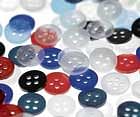
Buttons have been around since the Bronze Age nearly 3,000 years ago. Made of bone, horn, wood or sea shells, they were mainly used for embellishment rather than for holding clothes together.
French connection
Buttons arrived in Europe around the 12th century, introduced by the returning Crusaders. Soon after, they became a driving force in clothing design. The word ‘button’ is believed to have originated from either the French word ‘bouton’, which means ‘bud’ or from the word ‘bouter’, which means, ‘to push’.
The French were the first to realise the potential of this new accessory and established the Button Makers Guild around 1250. The guild produced beautiful buttons and soon France became the ‘Button Capital’ of Europe.
Buttons were worn mostly by men until the 18th century. By this time they were larger and had elaborate designs on them. As an integral part of the prevailing fashion, button making became an important industry.
People have tried making buttons from almost every material you can think of. Metals, of course, have been most popular, including iron, bronze, brass, copper, silver and gold.
Buttons made of shell, bone, mother of pearl, ivory, glass, stone, horn, leather, wood, ceramic, cloth, celluloid, bakelite and combinations of these have also been used over the years with varying popularity.
Queen Victoria started the fashion of wearing jet black buttons when she went into mourning for her husband, Prince Albert in 1861.
The bigger, the better
Buttons were made in varied shapes and sizes according to the dictates of fashion. Remember Georgette Heyer and her description of fashionable young men of the Regency period who sported ‘buttons the size of dinner plates’? Flowers, animals, birds were some of the popular motifs engraved on buttons. Others depicted monuments, buildings, bridges, film stars and opera stars, characters from fairy tales and nursery rhymes, sportsmen and politicians. Some antique buttons even have miniature paintings on them. There were special craftsmen who made these buttons.
Fall from grace
Buttons were considered a status symbol and it became a sort of challenge to own the largest, prettiest or the most intricate buttons, especially among the nobility.
According to a 1520 document, Francis I (1494-1547) of France went to meet Henry VIII of England in a costume that had 13,600 gold buttons. The first Duke of Buckingham had a suit and cloak covered with diamond buttons. Buttons became quite a mania until the Church denounced them as “the devil’s snare”, referring to the button-fronted dresses worn by women, and the Puritans condemned buttons as ‘sinful’.
Funky & futuristic
Thankfully, buttons are back in business. The Button Drawer, one of the most popular online button stores patronised by fashion designers the world over, features thousands of fashion and novelty buttons in metal, shell, bone, wood, ceramic and other material. Currently, they are said to have 2,533 styles for customers to choose from. Buttons created by Laurel Burch include decorated cats, elephants and fish. In fact, in today’s custom made clothes speciality buttons often take the place of fine jewellery. There are trendsetter buttons, buttons that ‘make a statement’, buttons that add whimsy and buttons that bring back memories.
Renaissance and Blue Moon Buttons claim to “search the globe for the beautiful and the unique” and offer buttons that are quirky, luxurious, formal, funky, futuristic, antique, distinctive or downright daring. For cutting-edge style, they have fun picture buttons, sophisticated geometrics and vintage-style plastics in popular patterns. Their inventory keeps changing constantly to meet the demands of the latest fashion trends. Trivia buffs may find this fascinating: button collecting is a hobby and collectors in the US formed a nationwide club in 1938 known as the National Button Society (NBS). They organise a national event every year to show off their collections.